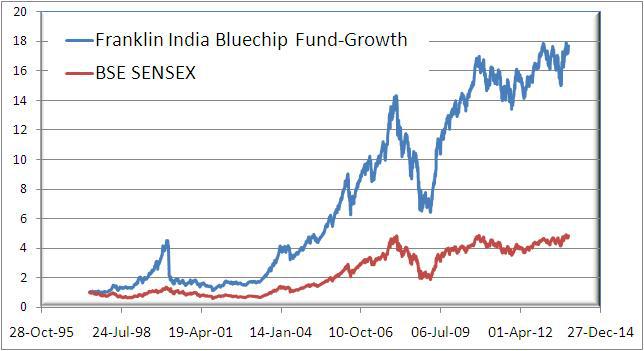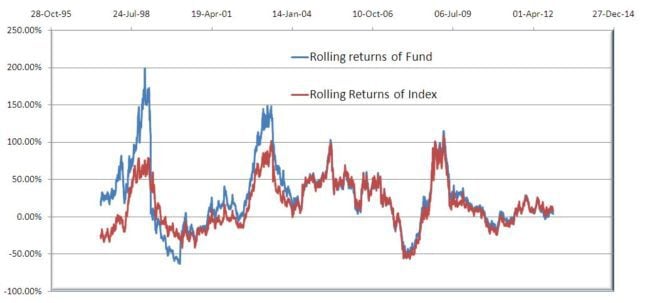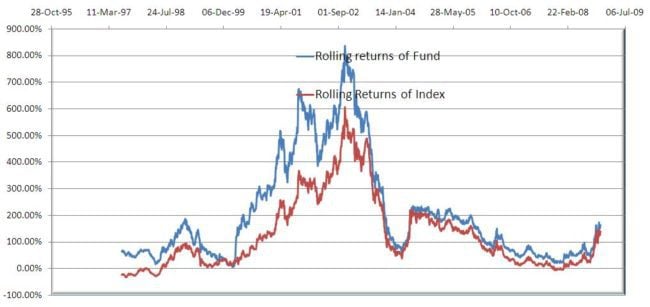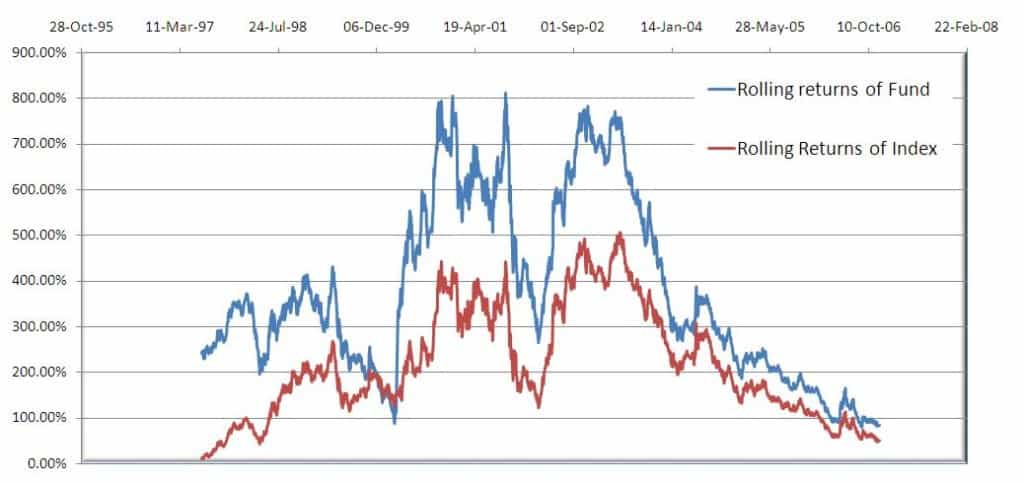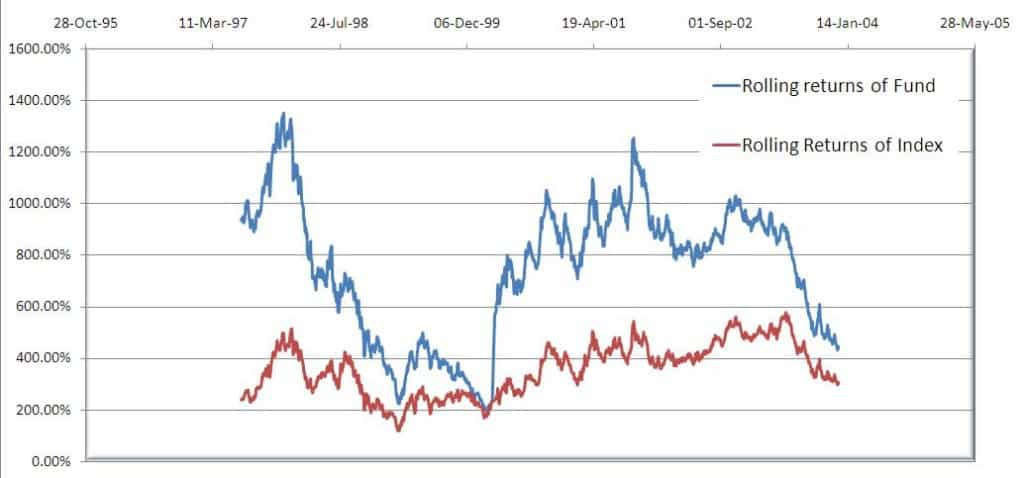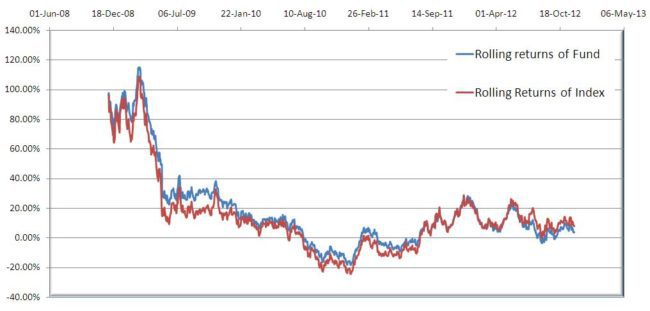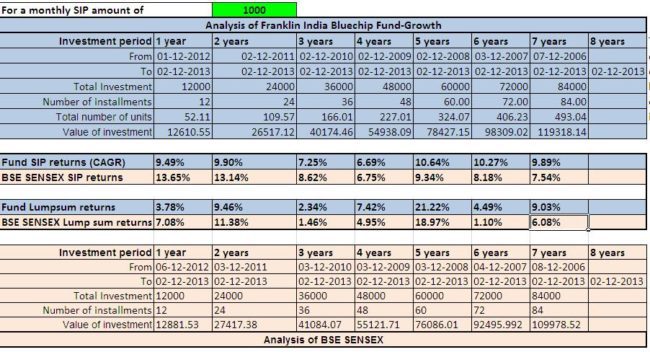Last Updated on January 12, 2023 at 10:01 pm
Regular readers of freefincal would recognize that the blog now has a decent set of resources for mutual fund evaluation and analysis.
I would like to encourage the use of these tools and calculators by publishing analysis of a few mutual funds from time to time. The aim is to make it clear that mutual fund analysis is not rocket science and can be done by anyone with an inclination.
My DIY analysis of HDFC Top 200 has now become reasonably popular. When I published the automated version of the mutual fund rolling returns calculators, I had used Top 200 again as an example.
In this post I would like to look at rolling returns data for Franklin India Blue Chip Fund, which requires little introduction. Many readers will be aware that FIBC is a 20 year old fund and an extraordinary alpha generator (alpha is the excess returns with respect to the fund benchmark – Sensex in this case).
Join 32,000+ readers and get free money management solutions delivered to your inbox! Subscribe to get posts via email! (Link takes you to our email sign-up form)
🔥Want to create a complete financial plan? Learn goal-based investing? Exclusive access to our DIY tools? Increase your income with your skills? Use this link to enjoy massive discounts on our robo-advisory tool & courses! 🔥
Before we being a quick explanation of what a rolling return is. Suppose I want to determine fund performance from 1st Jan 2000 to 31st Dec. 2012, I choose some interval. Let say this is one year.
- I calculate the return for the fund and its benchmark from 1st Jan. 2000 to 31st Dex. 2000.
- Then from 2nd Jan. 2000 to 1st Jan. 2001
- Then from 3rd Jan. 2000 to 2nd Jan 2001 and so on until I reach 31st Dec. 2012.
- This ‘rolling’ return is then plotted against the duration used.
- If the funds rolling returns is higher than the benchmarks most part of the graph, you can conclude that the fund has been consistent in its outperformance.
- Rolling returns give you an idea about consistency of funds performance with respect to its benchmark.
The following graphs were obtained with the Automated Rolling returns calculator, posted earlier. Since I wanted to analyse FIBCs performance for as long a time period as possible, I have manually entered NAV date from the AMCs website and Sensex data from Yahoo Finance.
1. FIBC vs Sensex (July 1997 to Dec. 2013)
That is an amazing graph! The gap between the fund and its benchmark is a sight for sore eyes! The graph has been normalized (NAV and SENSEX made ‘1’) from 1st July 1997. Therefore, this fantastic outperformance is valid only in the period displayed.
2. FIBC vs Sensex (July 1997 to Dec. 2013) 1Y Rolling Returns
Now that is not an amazing graph! For rolling returns, the value of the y-axis (returns) does not matter. What matter is this question:
Is the fund above its benchmark for a good part of the graph, or not?
Obviously when we consider one-year rolling returns from Jul. 1997 to Dec. 2013, the fund has not outperformed the Sensex.
So why all this fuss over FIBC? Watch what happens when the duration use in the rolling returns calculation is increased.
3. FIBC vs Sensex (July 1997 to Dec. 2013) 3Y Rolling Returns
4. FIBC vs Sensex (July 1997 to Dec. 2013) 5Y Rolling Returns
5. FIBC vs Sensex (July 1997 to Dec. 2013) 7Y Rolling Returns
6. FIBC vs Sensex (July 1997 to Dec. 2013) 10Y Rolling Returns
It is clear that longer the rolling return duration (and therefore the investment duration), higher the chances of outperforming the Sensex.
The point is, FIBC is not some magic fund which beats the Sensex year after year. It is a well managed fund which has beat the Sensex comfortably, provided one has shown faith and stayed invested.
Nothing new about this. Just good old common sense when it comes to equity investing.
The age of no alpha? The quantum of outperformance has decreased recently, regardless of the rolling returns duration. Does this mean we are entering into an age where it would be difficult to generate alpha? I don’t know.
All I know is this. If we wish to get returns that beat inflation, index investing is more than enough. The need to beat inflation is plain investing common sense. The need for alpha stems from our desire to create wealth or to put it bluntly, our greed. We should not confuse greed with investing common sense.
The last 5 years? Many believe that the last 5 years has been the most volatile period of the stock market. Although this is not true (proof is here), our view point is most often defined by recent history. So let see how FIBC has fared in the last 5 years.
7. FIBC vs Sensex (Dec 2008 to Dec. 2013)
In the last 5 years, the performance has been pretty decent, if not spectacular.
8. FIBC vs Sensex (Dec 2008 to Dec. 2013) 1Y Rolling returns
9. FIBC vs Sensex (Dec 2008 to Dec. 2013) 3Y Rolling returns
The 1 year rolling returns for the last 5 years again resembles the Sensex closely. The 3 year rolling return is much better.
Bottom line: Only patient investors who have kept the faith in FIBC have been rewarded.
What about SIP returns? Here is a snapshot of results obtained with the Mutual Fund SIP Returns Analyzer
The SIP returns for the last seven years has been listed along with lump sum returns.
As you can see, returns have been pretty decent and consistent.
If you are interested in a what if calculation, that is, if you want to determine SIP returns from FIBC for any duration since inception, you could try this: Daily vs. Monthly vs. Quarterly SIP
What are your thoughts on the above data?
I do hope you agree with that the above ‘analysis’ can be done by anybody if they have the interest and about 15-20 minutes to spare. I urge you to analyze your funds with the available mutual fund evaluation tools. I will be more than happy to share your findings in the blog as a guest post if you would like to do so.
The above analysis is based on bare Sensex data. That is one which does not include dividends. Swapnil wanted to know if it would make a difference if the dividends were included. I could not find such data for Sensex. Swapnil has given the link for the Nifty data with dividends included. So I have made a comparison of FIBCF vs. Sensex (bare) and FIBCF vs. Nifty (div. incl.) between 1st July 1997 t0 2nd Dec. 2013.
When we included dividends the outperformance is not as dramatic, especially in the last 10 years!!

Use our Robo-advisory Tool to create a complete financial plan! ⇐More than 3,000 investors and advisors use this! Use the discount code: robo25 for a 20% discount. Plan your retirement (early, normal, before, and after), as well as non-recurring financial goals (such as child education) and recurring financial goals (like holidays and appliance purchases). The tool would help anyone aged 18 to 80 plan for their retirement, as well as six other non-recurring financial goals and four recurring financial goals, with a detailed cash flow summary.
🔥You can also avail massive discounts on our courses and the freefincal investor circle! 🔥& join our community of 8000+ users!
Track your mutual funds and stock investments with this Google Sheet!
We also publish monthly equity mutual funds, debt and hybrid mutual funds, index funds, and ETF screeners, as well as momentum and low-volatility stock screeners.
You can follow our articles on Google News

We have over 1,000 videos on YouTube!

Join our WhatsApp Channel



- Do you have a comment about the above article? Reach out to us on Twitter: @freefincal or @pattufreefincal
- Have a question? Subscribe to our newsletter using the form below.
- Hit 'reply' to any email from us! We do not offer personalised investment advice. We can write a detailed article without mentioning your name if you have a generic question.
Join 32,000+ readers and get free money management solutions delivered to your inbox! Subscribe to get posts via email! (Link takes you to our email sign-up form)
About The Author
 Dr M. Pattabiraman (PhD) is the founder, managing editor and primary author of freefincal. He is an associate professor at the Indian Institute of Technology, Madras. He has over 13 years of experience publishing news analysis, research and financial product development. Connect with him via Twitter(X), LinkedIn, or YouTube. Pattabiraman has co-authored three print books: (1) You can be rich too with goal-based investing (CNBC TV18) for DIY investors. (2) Gamechanger for young earners. (3) Chinchu Gets a Superpower! for kids. He has also written seven other free e-books on various money management topics. He is a patron and co-founder of “Fee-only India,” an organisation promoting unbiased, commission-free, AUM-independent investment advice.
Dr M. Pattabiraman (PhD) is the founder, managing editor and primary author of freefincal. He is an associate professor at the Indian Institute of Technology, Madras. He has over 13 years of experience publishing news analysis, research and financial product development. Connect with him via Twitter(X), LinkedIn, or YouTube. Pattabiraman has co-authored three print books: (1) You can be rich too with goal-based investing (CNBC TV18) for DIY investors. (2) Gamechanger for young earners. (3) Chinchu Gets a Superpower! for kids. He has also written seven other free e-books on various money management topics. He is a patron and co-founder of “Fee-only India,” an organisation promoting unbiased, commission-free, AUM-independent investment advice.Our flagship course! Learn to manage your portfolio like a pro to achieve your goals regardless of market conditions! ⇐ More than 3,500 investors and advisors are part of our exclusive community! Get clarity on how to plan for your goals and achieve the necessary corpus no matter the market condition!! Watch the first lecture for free! One-time payment! No recurring fees! Life-long access to videos! Reduce fear, uncertainty and doubt while investing! Learn how to plan for your goals before and after retirement with confidence.
Increase your income by getting people to pay for your skills! ⇐ More than 800 salaried employees, entrepreneurs and financial advisors are part of our exclusive community! Learn how to get people to pay for your skills! Whether you are a professional or small business owner seeking more clients through online visibility, or a salaried individual looking for a side income or passive income, we will show you how to achieve this by showcasing your skills and building a community that trusts and pays you. (watch 1st lecture for free). One-time payment! No recurring fees! Life-long access to videos!
Our book for kids: “Chinchu Gets a Superpower!” is now available!


Must-read book even for adults! This is something that every parent should teach their kids right from their young age. The importance of money management and decision making based on their wants and needs. Very nicely written in simple terms. - Arun.Buy the book: Chinchu gets a superpower for your child!
How to profit from content writing: Our new ebook is for those interested in getting a side income via content writing. It is available at a 50% discount for Rs. 500 only!
Do you want to check if the market is overvalued or undervalued? Use our market valuation tool (it will work with any index!), or get the Tactical Buy/Sell timing tool!
We publish monthly mutual fund screeners and momentum, low-volatility stock screeners.
About freefincal & its content policy. Freefincal is a News Media organisation dedicated to providing original analysis, reports, reviews and insights on mutual funds, stocks, investing, retirement and personal finance developments. We do so without conflict of interest and bias. Follow us on Google News. Freefincal serves more than three million readers a year (5 million page views) with articles based only on factual information and detailed analysis by its authors. All statements made will be verified with credible and knowledgeable sources before publication. Freefincal does not publish paid articles, promotions, PR, satire or opinions without data. All opinions will be inferences backed by verifiable, reproducible evidence/data. Contact Information: To get in touch, please use our contact form. (Sponsored posts or paid collaborations will not be entertained.)
Connect with us on social media
- Twitter @freefincal
- Subscribe to our YouTube Videos
- Posts feed via Feedburner.
Our publications
You Can Be Rich Too with Goal-Based Investing
 Published by CNBC TV18, this book is designed to help you ask the right questions and find the correct answers. Additionally, it comes with nine online calculators, allowing you to create custom solutions tailored to your lifestyle. Get it now.
Published by CNBC TV18, this book is designed to help you ask the right questions and find the correct answers. Additionally, it comes with nine online calculators, allowing you to create custom solutions tailored to your lifestyle. Get it now.Gamechanger: Forget Startups, Join Corporate & Still Live the Rich Life You Want
 This book is designed for young earners to get their basics right from the start! It will also help you travel to exotic places at a low cost! Get it or gift it to a young earner.
This book is designed for young earners to get their basics right from the start! It will also help you travel to exotic places at a low cost! Get it or gift it to a young earner.Your Ultimate Guide to Travel
 This is an in-depth exploration of vacation planning, including finding affordable flights, budget accommodations, and practical travel tips. It also examines the benefits of travelling slowly, both financially and psychologically, with links to relevant web pages and guidance at every step. Get the PDF for Rs 300 (instant download)
This is an in-depth exploration of vacation planning, including finding affordable flights, budget accommodations, and practical travel tips. It also examines the benefits of travelling slowly, both financially and psychologically, with links to relevant web pages and guidance at every step. Get the PDF for Rs 300 (instant download)
